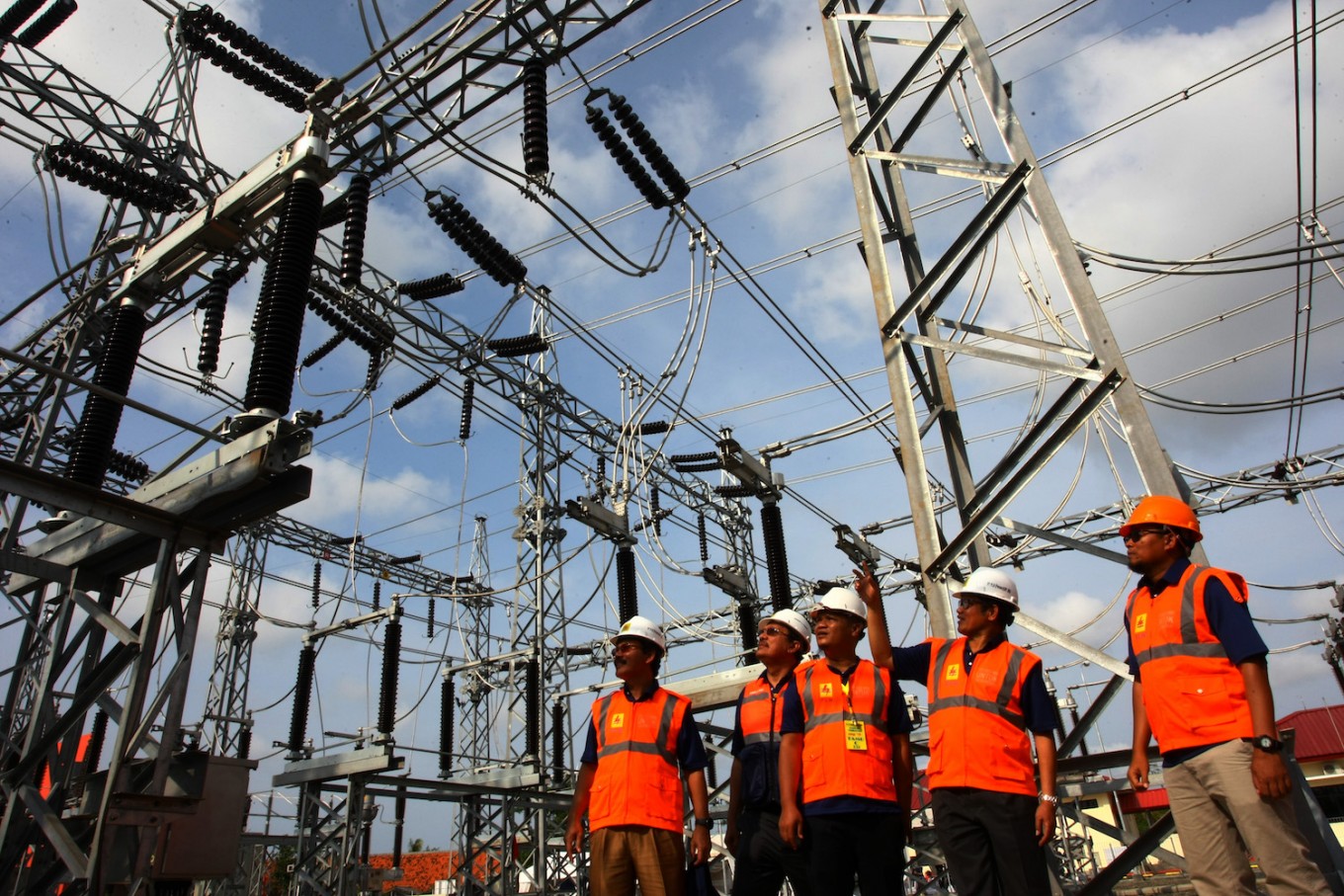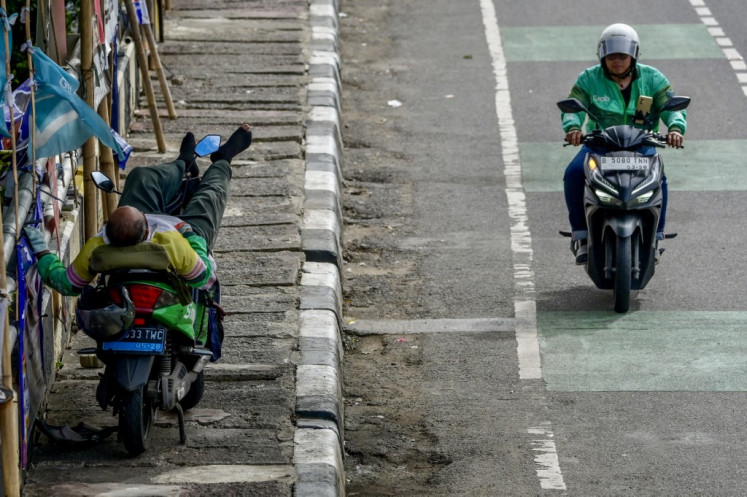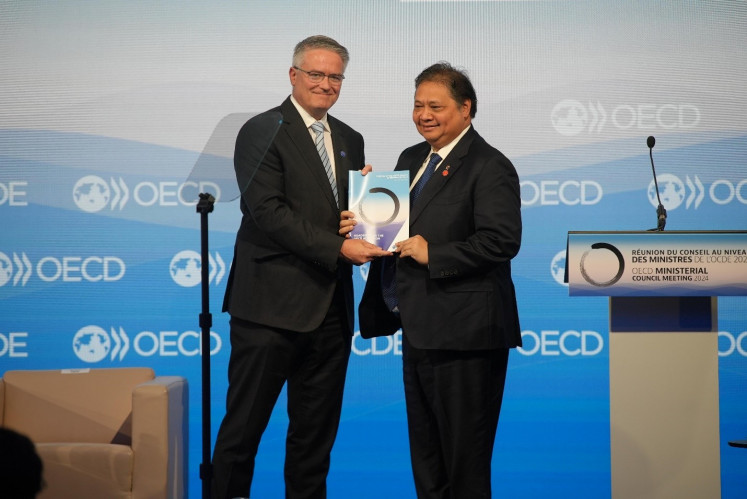Massive power projects: Is PLN up to the task?
About 75 percent of Jokowi’s envisioned 35,000 MW is slated to come from independent producers rather than from PLN-operated plants. This further places PLN at the mercy of the Ministry of Energy which controls not only its revenue, but also its costs.
Change Size
 State utility company PLN’s western Java region director, Haryanto (center), talks with field supervisors at power relay station Cengkareng II, in Tangerang, Banten, on Feb. 28. The regions have completed 67 power projects ahead of the 2018 Asian Games, while the power supply in the capital has also been increased.
(Antara/Muhammad Iqbal)
State utility company PLN’s western Java region director, Haryanto (center), talks with field supervisors at power relay station Cengkareng II, in Tangerang, Banten, on Feb. 28. The regions have completed 67 power projects ahead of the 2018 Asian Games, while the power supply in the capital has also been increased.
(Antara/Muhammad Iqbal)
W
hen President Joko “Jokowi” Widodo came into office in 2014, he pledged to jump-start investment in Indonesia’s infrastructure. Along with other ambitious goals he sought to add 35,000 MW of installed capacity to Indonesia’s power grid by 2019, and backed up that pledge by eliminating massive public subsidies for the oil and gas industry and putting those funds toward energy and transportation projects.
However, as of Feb. 1, 2018 only 1,362 MW of the planned 35,000 MW were operational. In its most recent 10-year business plan, state-owned electricity company Perusahaan Listrik Negara (PLN) slashed its 2028 targets by 22,000 MW citing lower than expected demand. And in early March, the Energy and Mineral Resources Ministry issued a regulation capping the price that PLN will pay for domestic coal at 30 percent below its current market price. This begs the question – is PLN capable of delivering the infrastructure goals it has been tasked with?
The state has a legal obligation to provide “reasonably priced” power to its citizens. The retail price of electricity is therefore tightly controlled by the democratically elected government and not by PLN. This places the utility at a disadvantage because when the cost of energy production increases it cannot pass those costs through to consumers, and that is especially true in 2018 and 2019 which are election years.
Although PLN maintains a strict monopoly on the transmission and distribution of power, since the 1990s it has increasingly sourced power from independent producers, entering into purchase agreements (typically 20-30 years in length) with private companies to buy power at fixed rates. About 75 percent of Jokowi’s envisioned 35,000 MW is slated to come from independent producers rather than from PLN-operated plants. This further places PLN at the mercy of the Ministry of Energy which controls not only its revenue, but also its costs.
Given these structural conditions, it is difficult to imagine how PLN can stay financially solvent without either increasing the retail price of electricity or relying on injections of capital from the state. Indeed, for years PLN’s main method of making up revenue shortfalls has been through large government capital transfers. Recently, the government voiced concern about continuing to carry PLN’s losses while also making it clear that retail rates would not be raised.
PLN’s solution was to revise its balance sheet in 2016. It used a new accounting method to value its fixed assets at their current market price, rather than their purchase price as had previously been the case. This valuation method allows for some degree of opacity in determining the worth of assets.
As described in their 2016 annual financial statement, the new values were calculated using (emphasis added) “data inputs observed from the market, [and] unobservable market data inputs and special assumptions related to the assets classified as specialized property, such as power plants, transmission and distribution networks.” Applied retroactively to 2015, the new valuation increased PLN’s assets from Rp 539 trillion (US$39.2 billion) in 2014 to 1.227 quadrillion rupiah ($$89.2 billion) the following year. This added Rp 687 trillion ($50 billion) of equity in a single year.
Since PLN has a constitutional mandate to own and operate its fixed assets, especially its massive transmission grids, it would be impossible in real terms to sell them and realize any of the increased value. The true purpose of such a large balance sheet adjustment was to borrow against the increase in assets, which is precisely what PLN did.
It secured a Rp 11.2 trillion loan ($813 million) from the Japan Bank of International Cooperation in April 2017, an additional Rp 8.3 trillion loan ($600 million) from the Asian Development Bank in September 2017, and a Rp 16.3 trillion loan ($1.2 billion) from a banking syndicate in November 2017. In mid-2017 it issued Rp 10 trillion of fixed rate bonds ($727 million), its first public bond offering in four years.
The company has announced plans to follow this up with $2 billion in rupiah-denominated global bonds in the second quarter of 2018. This flurry of financing activity is earmarked for funding capital expenditures, paying down debt and weaning the company off its reliance on government cash.
On the cost side, the government is doing its part to bring down PLN’s expenses. In addition to capping the price of domestic coal, the Ministry of Energy last year reduced the rates PLN could offer independent companies to produce renewable and coal-fired energy. This will be good for PLN’s bottom line but it will likely drive away private investment in the energy sector. Given that Jokowi’s 35,000 MW plan is hoping private companies will shoulder 75 percent of the load, this could be problematic.
PLN is thus caught in something of a bind. Retail electricity rates will remain frozen through the upcoming elections. The state is trying to ease the utility’s revenue shortfalls by bringing down costs, but doing so will stunt their ability to add capacity at the scale they promised. Further, PLN used a bit of accounting sleight of hand to revalue their assets and raise capital, which in theory will reduce their dependence on government funds in the short-term.
But while there was a demand for the utility’s bonds, one does wonder if that is because investors are confident in PLN’s underlying financials or because they know that the Indonesian state, as PLN’s sole shareholder, will ultimately step in and guarantee those obligations if anything should happen. Given that, it is unclear if the 35,000 MW goal will be realized. What is clear is that if the government is unwilling to raise retail rates or carry PLN’s losses, then the utility will be forced to continue loading up on questionable debt and that could spell trouble in the long-term.
***
The writer is a PhD candidate at the S. Rajaratnam School of International Studies in Singapore, with a research focus on Indonesia’s political economy.
---------------
We are looking for information, opinions, and in-depth analysis from experts or scholars in a variety of fields. We choose articles based on facts or opinions about general news, as well as quality analysis and commentary about Indonesia or international events. Send your piece to academia@jakpost.com.








